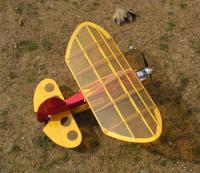Baby Bee
Frustrated with the Pico Stick, and
halfway through building an E-Starter but worried that it might be too
much for him, Dave sought another small, lightweight plane to practice
on -- one which would be more responsive than the Pico Stick, nearly as
crash-resistant, forgiving to fly, and nearly fully assembled, since
the E-Starter had already taken too much time to build and it wasn't
even finished yet.
Rummaging through the boxes at all the local hobby shops, he ended up
purchasing a Baby Bee. It looks nearly fully assembled as it sits
in the box, though it turned out to need more assembly than we thought
-- you have to iron the covering (fortunately I still had a monokote
iron left over from my previous R/C experience), cut covering in order
to glue the tail onto the fuselage, and install the control horns as
well as installing the radio gear. Still, this was done in one
long afternoon and evening.
 The Baby Bee
assembled and ready for its first flight.
The Baby Bee
assembled and ready for its first flight.
The Baby Bee has a relatively substantial engine (it looks quite a bit
bigger than the one in the Pico Stick) but we didn't buy new batteries
for it, and intended to fly it with the little 170mAh and 270mAh
ni-cads we'd been using in the Pico. Dave taxied it around the
backyard a bit, and pronounced it too underpowered to lift into the
air. I was skeptical, but all we could do was try.
So off we went to the flying field, with his Baby Bee and my Formosa in tow. It was a lovely still
day, but of course the wind picked up about the time we arrived.
Still, it wasn't very windy. We started with the small
battery. I allowed a fair amount of runway and started taxiing --
and the plane almost immediately swung around in a ground loop.
Tried again -- ground loop the other direction. It took a couple
of tries, but eventually I got it to taxi straight. But it didn't
seem to want to lift off, even at full throttle. I tried a few
times, but no luck. So we tried the bigger, 270mAh battery.
With this battery it was able to lift into the air. I got maybe
ten or twenty feet off the ground, getting the feel for the airplane
and circling back around. It needed very little trim adjustment,
though I had to correct constantly for wind gusts. But as I
circled around, I could tell it was having trouble maintaining an
altitude above that of the flying plateau (it was dipping into the
valley below), so I headed straight back for the runway with throttle
at full. I made it back to the runway for a nice crosswind
landing -- whew!
Then I turned to see Dave's downcast face. "It looked pretty
squirrelly." "Yeah, a bit." "There is no way I
could fly that." "Well, uh ... maybe once we get it trimmed out
..." "No way."
He's probably right. It's cute as a button, but it really isn't a
great trainer.
He still has the E-Starter, and when we went to the hobby shop to pick
up some parts for my Formosa which I
wrecked shortly after landing the Baby Bee, some guys there talked him
into buying a Slow Stick, swearing to him that it wasn't anything like
the Pico Stick and that he'd love it. It's just about ready to go
-- we'll know tomorrow.
More Planes
Shallow Sky Home
 The Baby Bee
assembled and ready for its first flight.
The Baby Bee
assembled and ready for its first flight.